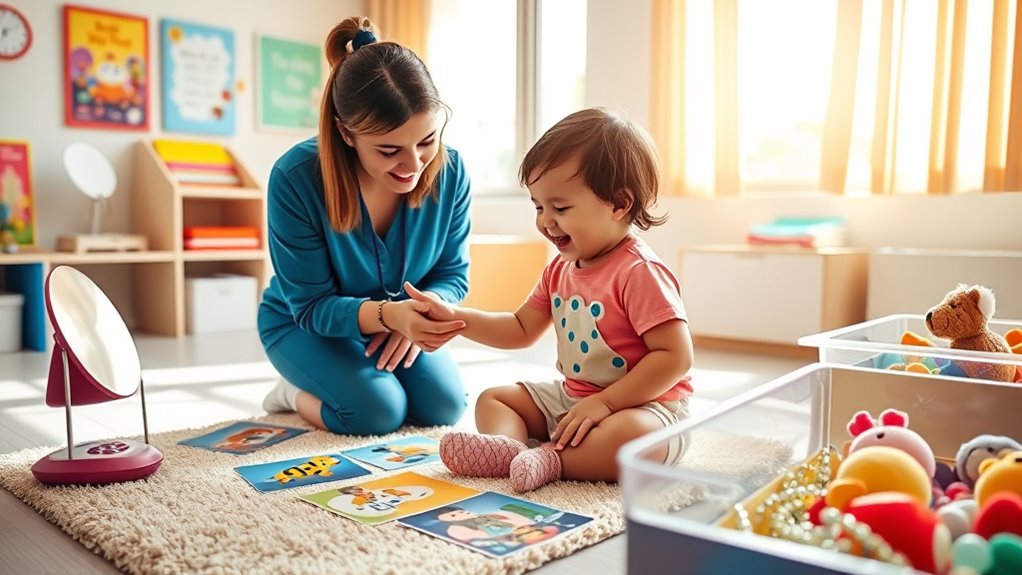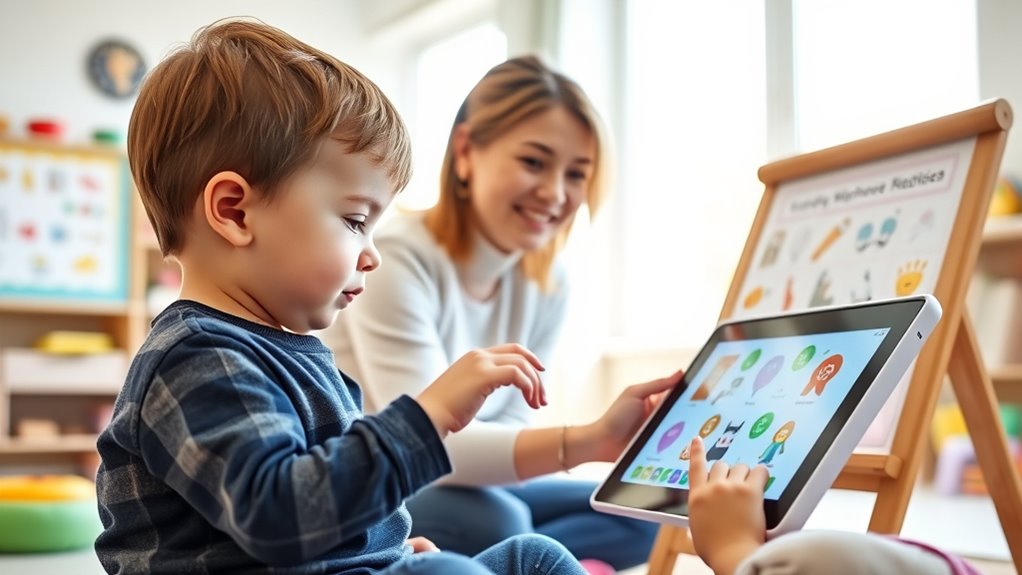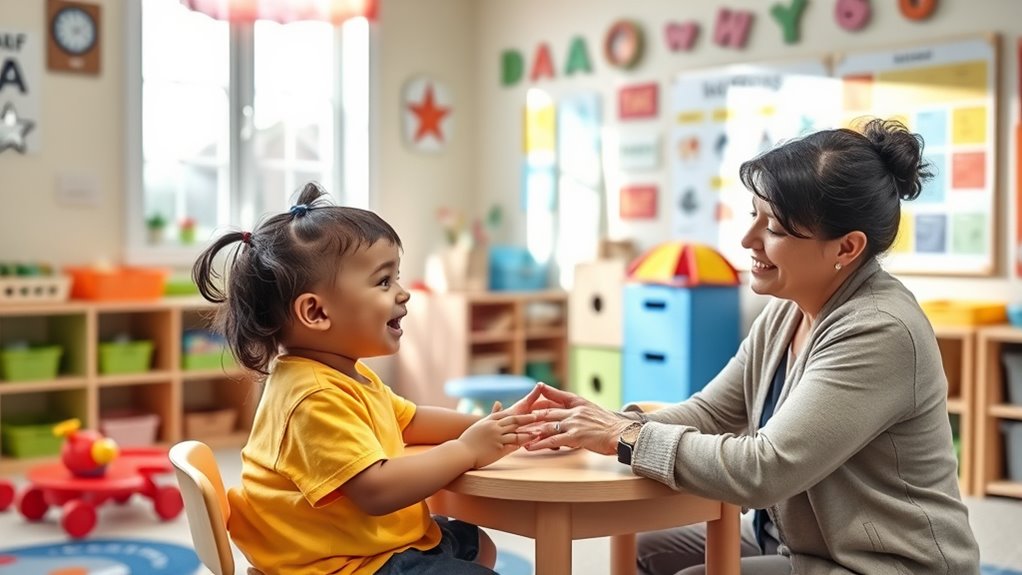Early intervention programs are vital for helping your deaf toddler develop language skills early on. By getting regular hearing screenings and choosing appropriate therapy options, you can support their communication growth. Family involvement and the use of technology, like assistive devices and interactive apps, boost progress. Creating a supportive environment and accessing the right programs can make a big difference. Keep exploring to learn more about effective strategies for your child’s success.
Key Takeaways
- Early detection through regular screenings enables timely intervention, supporting optimal language development in deaf toddlers.
- Family-centered programs involving caregivers and siblings reinforce communication skills within a supportive environment.
- Evidence-based therapies utilizing visual cues, play, and technology enhance engagement and language acquisition.
- Assistive devices like hearing aids and cochlear implants improve sound access, facilitating better learning opportunities.
- Creating positive, routine-based home environments encourages consistent practice and fosters social and emotional growth.
The Importance of Early Detection and Diagnosis

Early detection and diagnosis of hearing loss in deaf toddlers are essential because they allow for timely intervention, which can greatly enhance language development and overall communication skills. Understanding that genetic factors often contribute to hearing loss helps identify at-risk children early on, enabling prompt testing and diagnosis. Environmental influences, such as exposure to loud noises or infections, also play a role in hearing health, making awareness critical. When you catch hearing issues early, you can start interventions sooner, which supports your child’s ability to develop language naturally and confidently. Delaying diagnosis can hinder auditory development and limit future communication opportunities. Consequently, regular hearing screenings, especially if there’s a family history or environmental risk, are fundamental for ensuring your child gets the support they need from the start.
Types of Intervention Programs Available

There are several intervention programs designed to support your child’s development, with speech and language therapy being a key option. Family-centered approaches involve you actively in your child’s progress, ensuring support fits your family’s needs. Understanding these options helps you choose the most effective strategies to support your child’s communication skills. Additionally, being aware of state tax implications can help families plan their finances effectively during retirement. For those seeking effective tools, the best vacuums for dust removal in 2024 can assist in maintaining a clean environment that supports your child’s health and development. Knowing about refrigerant leaks can also be beneficial if you want to ensure your heating and cooling systems operate efficiently and safely. Recognizing emotional support strategies can further enhance your child’s adaptation and well-being as they develop new communication skills.
Speech and Language Therapy
Speech and language therapy offers a variety of intervention programs tailored to meet the unique needs of deaf toddlers. These programs focus on improving communication skills by enhancing voice recognition and speech clarity. During therapy, you’ll work with specialists who use targeted techniques to help your child recognize sounds and produce clearer speech. Incorporating evidence-based practices ensures that the interventions are effective and aligned with current research. You may encounter approaches like:
- Auditory-verbal therapy to strengthen listening skills
- Speech reading exercises for better sound recognition
- Phonemic awareness activities to improve speech clarity
- Use of assistive devices to support voice recognition
- Interactive play to encourage expressive language development
Each program is designed to foster your child’s ability to communicate confidently, setting a strong foundation for language growth and social interaction. With increased interest in diverse strategies, incorporating alternative investments like assistive devices can enhance therapy outcomes and multimodal communication methods. Additionally, integrating early intervention techniques can significantly improve language development trajectories for deaf toddlers.
Family-Centered Approaches
Have you considered how involving your family in your child’s intervention can make a difference? Family-centered approaches prioritize your child’s development within the context of your family dynamics. These programs actively include parents, siblings, and other caregivers, fostering a supportive environment for language growth. Sibling involvement, in particular, can boost your child’s confidence and natural language use, as siblings often serve as engaging communication partners. By participating in therapy activities and learning strategies together, your family can reinforce skills at home, creating consistency and encouragement. This collaborative approach helps your child feel secure and motivated, making progress more effective. Recognizing the importance of color accuracy and contrast ratio, family-centered programs understand that your family’s unique dynamics are essential to your child’s success and long-term communication development.
Role of Speech and Language Therapy

Early intervention with speech and language therapy plays a crucial role in supporting deaf toddlers’ communication development. Through tailored approaches, you help your child develop essential skills, whether using sign language or auditory training. Speech therapists assess your child’s needs and design personalized strategies to improve understanding and expression. They focus on building a strong foundation for language, boosting confidence and social interaction. You might work on:
Early speech and language therapy supports deaf toddlers’ communication and social skills development.
- Incorporating sign language to enhance communication
- Developing auditory training routines for listening skills
- Encouraging speech through play and repetition
- Using visual cues to support understanding
- Tracking progress and adjusting techniques as needed
Implementing predictive modeling can help identify your child’s evolving needs and optimize intervention strategies. This technology allows for more personalized therapy plans tailored to individual progress. This therapy empowers your child to communicate effectively, laying the groundwork for future language success and social engagement. Early assessment is also vital to ensure timely and appropriate support from the outset.
The Impact of Family Involvement and Support

Your involvement plays a vital role in your child’s development, and implementing effective engagement strategies can make a real difference. Consistent communication at home reinforces learning and helps your child feel supported. Providing emotional and social support creates a nurturing environment that fosters confidence and growth. Additionally, creating a supportive environment at home encourages healthy emotional development and strengthens your bond with your child. Recognizing mental clarity and focus through organized and clutter-free spaces can also support your child’s overall well-being and development. Incorporating home safety tips can further ensure a secure space where your child can thrive.
Parental Engagement Strategies
Family involvement plays a crucial role in the success of early intervention for deaf toddlers. Your active participation enhances their language development and emotional bonding. To engage effectively, try using play-based strategies that encourage spontaneous communication and exploration. Focus on creating a supportive environment where your child feels safe and loved. Simple activities like singing, reading, and playing with sound toys strengthen emotional bonds and stimulate language skills. Incorporate elements of cozy textiles and natural materials to make the environment inviting and comforting. Creating a positive learning environment helps your child associate communication with positive experiences. Consistent interaction helps your child associate communication with positive experiences. Remember, your enthusiasm and patience inspire confidence. Incorporate routines that promote joint attention and shared enjoyment. Utilizing family involvement and natural materials in daily routines can further enhance your child’s engagement. Being present and involved, and understanding the importance of early intervention, sets the foundation for your child’s future success in language and social skills. Additionally, understanding the importance of evidence-based practices can guide you in supporting your child’s development effectively.
Consistent Home Communication
Consistent communication at home plays a pivotal role in supporting your deaf toddler’s language development. Incorporating home routines and daily interactions helps reinforce new skills and creates a predictable environment for learning. Your active involvement encourages your child to engage and practice communication regularly. Establishing routine activities like mealtime, reading, and playtime provides natural opportunities to model language and reinforce understanding. Additionally, regular aeration during activities like play and storytelling can support the natural decomposition of language exposure, fostering better comprehension and expressive skills through consistent engagement. Utilizing professional equipment can further enhance the quality of spoken interactions and recordings at home.
Emotional and Social Support
When family members actively participate in a deaf toddler’s emotional and social development, they create a supportive environment that fosters confidence and connection. Your involvement helps build emotional resilience, allowing your child to navigate social situations with greater ease. Encouraging peer relationships is crucial, as they teach sharing, empathy, and cooperation. You can support this by arranging playdates and promoting inclusive activities. Celebrating small social wins boosts your child’s self-esteem and resilience. Listening attentively to their feelings and validating emotions strengthens trust and emotional security. Remember, your consistent support helps your toddler develop essential social skills and resilience that will serve them throughout life. Incorporating wall organization into your home can also create a calming space that supports your child’s social interactions and emotional well-being.
Technology and Tools Enhancing Language Development

Advances in technology have revolutionized how we support language development in deaf toddlers. Assistive devices, like hearing aids and cochlear implants, help children access sounds crucial for language learning. Digital applications also play a essential role, offering interactive activities that promote vocabulary, comprehension, and communication skills. These tools enable consistent practice and engagement beyond therapy sessions, making learning more accessible and enjoyable. You can tailor digital content to your child’s interests, encouraging active participation. Additionally, real-time feedback from these tools helps identify areas needing improvement, allowing for targeted support. By integrating assistive devices and innovative applications into your child’s daily routine, you create a dynamic learning environment that accelerates language development and builds confidence.
Success Stories: Real-Life Examples of Progress

Real-life success stories demonstrate how technology and dedicated support can transform language development for deaf toddlers. You’ll see children making remarkable progress through targeted programs that include music therapy and peer interactions. These approaches help boost communication skills and build confidence. For example:
Real stories show how support and technology unlock language potential in deaf toddlers.
- A toddler improves vocabulary using music therapy combined with visual cues
- Peer interactions foster social skills and encourage spontaneous language use
- Children develop listening skills through engaging, multisensory activities
- Parents report increased confidence in supporting their child’s communication
- Early intervention enables children to participate more fully in social settings
These stories highlight how personalized, supportive strategies can turn challenges into achievements, inspiring hope for families steering through deafness. Each success reaffirms that early intervention makes all the difference.
How to Access and Choose the Right Program

Choosing the right program for your deaf toddler can feel overwhelming, but understanding how to access quality services makes the process manageable. Start by researching local agencies and asking for recommendations. Ensure the program’s funding sources align with your needs, whether it’s government grants, insurance, or community support. Cultural considerations are vital; select programs that respect and incorporate your family’s language and cultural background.
| Program Funding | Cultural Considerations |
|---|---|
| Seek programs with transparent funding | Find programs that honor your family’s language and traditions |
| Confirm financial assistance options | Ensure cultural sensitivity in curriculum and staff training |
Frequently Asked Questions
How Do Intervention Programs Differ for Children With Varying Degrees of Hearing Loss?
You might wonder how intervention programs differ based on hearing loss levels. For mild loss, programs often focus on hearing aids and speech therapy to improve spoken language. For moderate to severe loss, you may need more intensive support, including cochlear implants alongside speech therapy. Tailoring interventions guarantees each child receives appropriate tools and therapy, helping them develop communication skills suited to their specific hearing abilities.
What Are the Long-Term Benefits of Early Language Intervention for Deaf Toddlers?
Like planting a seed that blooms, early language intervention sets the stage for lasting growth. You’ll see improved language development, helping your child express themselves confidently. It also promotes social integration, allowing your child to connect with peers and build relationships. Over time, these benefits foster independence and self-esteem, giving your child a strong foundation for future success. Early support truly shapes a brighter, more connected future.
How Can Parents Advocate Effectively for Their Child’s Early Intervention Services?
You can advocate effectively for your child’s early intervention services by using advocacy strategies that emphasize parent empowerment. Stay informed about available programs, ask questions, and communicate openly with providers. Attend meetings confidently, share your child’s needs, and collaborate with professionals. Your active involvement and knowledge give you the power to guarantee your child receives the support they need, making a lasting difference in their language development and overall growth.
Are There Community Resources Available to Support Ongoing Language Development?
You might wonder if community resources exist to support ongoing language development. The truth is, community centers often offer programs and activities designed to foster language skills, while peer groups provide invaluable social interaction for deaf toddlers. These resources can enhance your child’s communication abilities, giving them more opportunities to practice and grow. Exploring local community centers and connecting with peer groups can make a significant difference in your child’s language journey.
What Challenges Might Families Face When Implementing Intervention Strategies at Home?
When implementing intervention strategies at home, you might face challenges with family engagement and resource accessibility. It can be difficult to find time, stay consistent, or understand how best to support your child’s language development. Limited access to resources or guidance may also hinder progress. Staying connected with professionals and community programs can help, but overcoming these obstacles requires patience and proactive effort to guarantee your child receives consistent support.
Conclusion
Remember, the earliest steps often lead to the brightest futures. By embracing available programs and supporting your child’s journey, you open doors to a world of words and connection. With patience, love, and the right tools, you can help your little one find their voice and flourish. Every moment you invest plants seeds of confidence and joy, guiding them toward a future where communication blooms beautifully.











